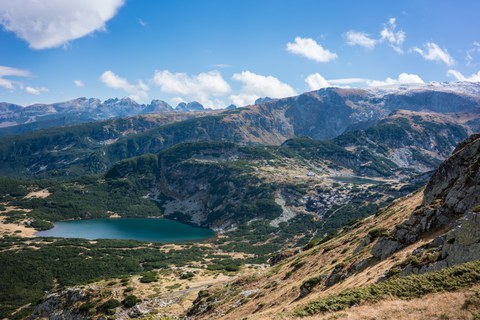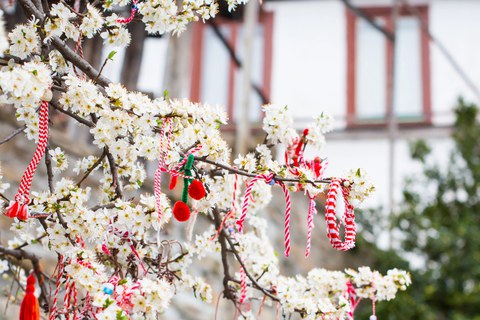Partner Country of the Month November 2022: Bulgaria
Bulgaria, where was that again? This south-eastern European country lies between Romania, Greece and Turkey on the shores of the Black Sea. Covered by extensive forests and mountain ranges, Bulgaria impresses with natural beauty. As one of the oldest countries in Europe, it looks back on a long and variable history, beginning with the earliest traces of mankind in Europe. Bulgaria is the home of the Cyrillic alphabet and of yoghurt. Let's discover more!
With the "Partner Country of the Month" campaign, we want to shine a spotlight on the wide diversity of countries, regions and partner universities of TU Dresden that our students can explore during a semester abroad.
Table of contents
General facts and figures about Bulgaria
Capital: Sofia
Population: about 6.5 million
Official language: Bulgarian
National holiday: March 3 (day of independence from the Ottoman Empire)
Currency: Lev (лв / BGN)
You can find further facts, figures and information on Wikipedia, on bulgariatravel.org or e.g. on wikivoyage.
Language matters
- Hello – Здравей zdravey
- My name is … – Казвам се … kazvam se …
- Excuse me - Извинете isvinete
- Thank you – Благодаря blagodarya, or frequently: Merci
- Where is (the bathroom)? – къде е (тоалетната) – Kude e (toaletnata)?
- I don’t speak Bulgarian. - Аз не говоря български. As ne govorya balgarski.
- Yes – да da
- No – не ne
- See you - Чао chao
Bulgarian is part of the Slavic language family and has much in common with Macedonian and Serbian. A special feature of Bulgarian is its lack of cases, whereas a full 6-7 of them are typical of Slavic languages. Bulgarian is written in Cyrillic script. Today, Cyrillic is probably most closely associated with Russian and Ukrainian, but it was invented in Bulgaria in the 10th century. Therefore, Bulgarian is the oldest recorded Slavic language.
Our partner universities offer a wide variety of courses in Bulgarian and English, and some in Russian as well. It’s completely possible to study entirely in English during your exchange. However, please check the exact requirements before applying.
Not too long ago, Russian used to be the most widely known foreign language in Bulgaria, but the ratio has reversed in favour of English. Younger Bulgarians, especially in the big cities, often speak English very well. So don't be afraid of the language barrier - but to delve deeper into local culture, some knowledge of Bulgarian is certainly helpful. You can study Bulgarian e.g. online at bulgaro.io or at the VHS (starting from German).
Did you know that ....?
- in spring, the trees in Bulgaria are full of red and white ribbons and yarn dolls? They are called Martenitsas. Bulgarians gift them to each other on the first day of March and wear them as bracelets or pendants afterwards. On seeing a blossoming tree, a stork or a swallow, the Martenitsa is tied to a branch to celebrate the beginning of spring.
-
in Bulgaria, the meaning of nodding and shaking your head is reversed? Contrary to most of the rest of the world, Bulgarians mean "yes" when shaking their head and "no" when nodding.
-
Bulgaria is the world's largest producer of rose and lavender oil? Rose oil production has a long history in Bulgaria. Cultivation takes place mainly in the Rose Valley. During the picking season from May to June, the whole valley is filled with the scent of roses. What’s more, Bulgaria overtook France in lavender oil production during the last decade. So, the French Provence is far from the only place to find colourful lavender fields.
-
Thracian fire dancing is celebrated in some villages of southern Bulgaria? The Thracians lived west of the Black Sea in antiquity. This fire dance, called Nestinarstvo, is an ancient custom and counts among the world’s cultural heritage. For dancing, fire is set in a circle. The dancers move barefoot over the burning ashes in intricate steps.
-
that Bulgaria is part of the Blue Heart of Europe? This refers to the many natural river landscapes on the Balkan Peninsula. About 80% of its flowing waters are in good or very good condition - more than almost anywhere else in Europe. Bulgaria is also special in other ways to do with water. Except Iceland, it has more thermal springs than any other European country.
Cooperation with TU Dresden
You can find all cooperations of TU Dresden in our database. Have a look at the experiences of our previous exchange students at Questionnaires. Professors at your faculty may have direct contacts to your partner university of choice and can advise you.
Our cooperations with Bulgarian universities are part of Erasmus+. You can find the contact persons and application deadlines for your faculty here.
Our Bulgarian partner universities via Erasmus+
Partner universities in Sofia
- University of National and World Economy
- Business Administration and Economics
- University of Architecture, Civil Engineering and Geodesy
- Civil Engineering
- Hydro Sciences
- Technical University of Sofia
- Manufacturing Science and Engineering
Partner universities in other cities
- Plovdivski Universitet 'Paisii Hilendarski' in Plovdiv
- Slavic Studies
- German as a Foreign Language
- Trakia University in Stara Sagora
- Medicine
- Medicinski Universitet in Varna
- Medicine
-
South-West University "Neofit Rilski" in Blagoevgrad
-
Textile machinery and high performance material technology
-
Don't miss...
A concert in the Ancient Theatre of Philippopolis. Plovdiv's most famous building bears witness to the city's many millennia of history. As one of the best-preserved Roman amphitheatres, it still impresses with its good acoustics. In summer, it's a unique venue for concerts, plays and many other events. The genres played are various, like the many metal bands that have rocked the ruins. Upcoming events can be found on e.g. on Facebook.
July Morning at the Black Sea. It's a Bulgarian hippie tradition - on June 30th, people gather in many places at the coast of the Black Sea to spend the summer night outdoors, sitting around bonfires, celebrating and playing music. Early in the morning on 1st July, they greet the rising sun with the song July Morning by Uriah Heep. Sometimes, there's a band (as on the cliffs of Kamen Bryag), sometimes people sing in small groups.
Rila Monastery is an important national monument and a must-see among Bulgarians, who have usually visited it at least once in their life. During the period of Ottoman rule over Bulgaria (1396-1878), much of its cultural heritage was preserved here. The monastery impresses with its architecture and countless frescoes. Buses go from Sofia, making it easy to visit as a day trip. If you have a little more time, the surrounding national park with its many mountain lakes and forests is also worth a visit.
The Archaeological Museum Varna in our partner city is home to the oldest gold treasure in the world. The 3,000 gold pieces stem from the Neolithic period and were found at the gravesites of a necropolis near Varna. In addition to this crown jewel of the collection, the museum contains many other finds dating from prehistory to the 19th century. So it's well worth a visit.
The Melnik Earth Pyramids amaze with a landscape of bizarre shapes washed out of sandstone and limestone rocks. Besides the eponymous earth pyramids, you can find steep rock spires, stone mushrooms and formations resembling alpine mountains in miniature. There is a direct bus line running daily from Sofia to the small town of Melnik, which is the starting point for hiking tours through the pyramids.
Let's get cooking...
Bulgarian cuisine combines Eastern European, Greek and Turkish elements into a unique mix. Typical ingredients are salty cheese, fresh or pickled vegetables and yoghurt, which is often said to have its origins in Bulgaria. The savory and herb mixture chubritsa is a common seasoning, as is lyutenitsa, an ajvar-like sauce made from peppers and tomatoes. Well-known dishes include Shopska salad, banitsa, a cheese filo pastry often eaten for breakfast, and the summery cucumber soup tarator. Rakia, a fruit brandy, is considered the national drink.
Bob Chorba
The hearty soup Bob Chorba is a national dish of Bulgaria. It tastes especially good when cooked in a clay pot put into a fireplace, but a normal pot on the stove will do. Bob Chorba is eaten all year round. It’s also part of the Christmas Eve feast, which is peculiar in requiring an odd number of dishes (usually 7, 9 or 11), all of which must be vegan. Besides Bob Chorba, the feast typically includes dishes like pumpkin strudel, stuffed cabbage and vine leaves, and bread with a lucky coin baked into it. Cooking a whole feast might be a bit too much effort – so here is just the recipe for a good Bob Chorba.
Contact
Have you had a great time in Bulgaria? Do you have tips for places and experiences that are not to be missed? We would be happy to share your experiences here, on social media or, if you want, in information events for other TUD students. Get in touch with us:
 © Sven Ellger/TUD
© Sven Ellger/TUD
Advice on studying abroad
NameMs Federica Serra
Infocenter/ Study abroad; TUDworldwide: America
Send encrypted email via the SecureMail portal (for TUD external users only).
Visiting address:
Fritz Foerster Bau, Office 161 Mommsenstraße 6
01069 Dresden
Postal address:
TUD Dresden University of Technology International Office
01062 Dresden
Office hours:
- Tuesday:
- 09:30 - 11:30
- 12:30 - 14:30
- Thursday:
- 09:30 - 11:30
Please register at the SCS (FOE, floor 0).
Looking for first-hand information?
Would you like to know more about Bulgaria? Ask our alumni ambassadors - TUD alumni who are active in many countries around the world and can give you information and advice for your stay abroad.
Getting in touch is very easy: On this interactive world map, markers indicate the cities where our alumni ambassadors live. There is a short profile with contact information for each ambassador.
Partner Countries Archive
Have you missed a partner country? No worries! Here you can read up on all articles.
|
Europe (Erasmus+) |
|
|
Africa |
|
|
America |
|
|
Asia |
|
|
Australia and Oceania |
|








